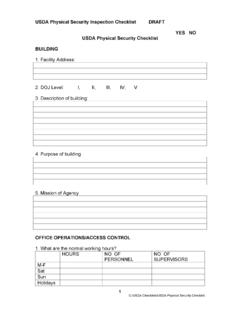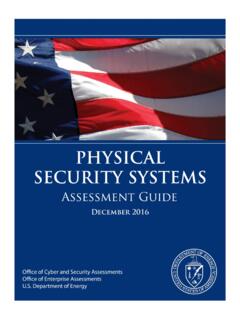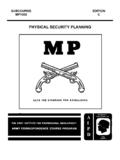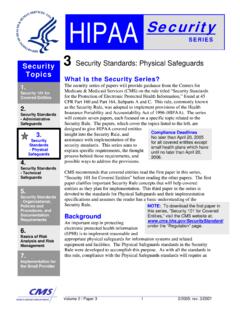Transcription of Student Guide Course: Introduction to Physical Security
1 February 2015 Center for Development of Security Excellence Page 1 Student Guide Course: Introduction to Physical Security This training course will introduce you to Physical Security . You'll learn about four main areas: Physical Security and the roles it involves; Security -in-depth; countermeasures; and Physical Security planning and implementation. Lesson 1: Physical Security and Roles Introduction to Physical Security 1. Lesson Introduction This lesson is about Physical Security and the roles people play in this continuing effort. The first part of this lesson will provide an overview of Physical Security policy and history. The second part of this lesson will focus on the roles, responsibilities, and relationships of Security professionals in the Physical Security discipline. At the end of this lesson, you will be able to identify The purpose of Physical Security The history of executive policy documents for Physical Security Department of Defense (DoD) policy documents for Physical Security Roles, responsibilities, and relationships of various command and activity officials relating to Physical Security 2.
2 Overview Physical Security is defined as that part of Security concerned with active, as well as passive measures, designed to prevent unauthorized access to personnel, equipment, installations, materials, and information; and to safeguard them against espionage, sabotage, terrorism, damage, and criminal activity. Physical Security is a major responsibility for installations and facilities. Safeguarding the national Security and other Department of Defense, or DoD, assets is not something that is ever taken lightly. In this lesson, you will learn why we have Physical Security , how it evolved through the years, how it is mandated throughout the DoD community, and about the various roles, responsibilities, and relationships of Security professionals in this continuing effort of Physical Security . Introduction to Physical Security Physical Security and Roles Student Guide February 2015 Center for Development of Security Excellence Page 2 3.
3 Purpose of Physical Security The two primary purposes of a Physical Security program are prevention and protection. Properly designed and executed Physical Security programs should deter or prevent, to the greatest degree possible, the loss, theft, or damage to an asset. Our assets are our most critical resources and include personnel, information, equipment, facilities, activities, and operations. Combined, these assets are referred to as PIE-FAO. Deterrents such as guards, signs, dogs, and fences, typically provide sufficient protection against general criminal activity. Because the United States of America now faces the possibility of terrorist threats like no other time in history, it is paramount that Physical Security be taken very seriously. 4. History of Executive Policy Documents Now let's explore the history of executive policies for Physical Security . Physical Security has been around since the beginning of mankind.
4 There has always been a need for the protection of one s belongings. Through the years, the purpose of Physical Security has largely remained the protect our assets. However, the methods used in the Physical Security Program have changed significantly. In December 1952, President Truman signed an Executive Order which provided Physical Security for facilities deemed important to the national defense mission. In September 1962, President Kennedy signed an Executive Order prescribing responsibilities of the Office of Emergency Planning in the Executive Office of the President. Essentially, this order made directors of agencies responsible for informing the President of what actions were necessary to physically protect facilities and other assets to national Security . In July 1979, President Jimmy Carter signed an Executive Order to establish the Federal Emergency Management Agency, or FEMA. This agency is charged with planning for national emergencies.
5 In November 1988, President Ronald Reagan signed an Executive Order that assigned the responsibilities of preparedness for all of the DoD to the Chairman of the Joint Chiefs of Staff, and the responsibility of antiterrorism and force protection to the Secretary of Defense. On September 11, 2001, the largest attack by terrorists in the occurred. As a direct result of these terrorist attacks, the Congress passed, and President Bush signed the Homeland Security Act of 2002, creating the Department of Homeland Security , or DHS. Introduction to Physical Security Physical Security and Roles Student Guide February 2015 Center for Development of Security Excellence Page 3 On October 8, 2001, President George W. Bush signed Executive Order 13228, Establishing the Office of Homeland Security and the Homeland Security Council. On October 16, 2001, President George W. Bush signed Executive Order 13231, Critical Infrastructure Protection in the Information Age.
6 This order ensures the Physical Security of information systems for critical infrastructure, including emergency preparedness communications, and the Physical assets that support such systems. On August 27, 2004, President Bush signed Homeland Security Presidential Directive 12, or HSPD-12, Policy for a Common Identification Standard for Federal Employees and contractors. This requires government-wide development and implementation of a standard for secure and reliable forms of identification for Federal employees and contractors. In February 2013, President Barack Obama signed Executive Order 13636, Improving Critical Infrastructure Cybersecurity, and Presidential Policy Directive 21, or PPD-21, Critical Infrastructure Security and Resilience. The policies set forth in these directives are intended to strengthen the Security and resilience of critical infrastructure against evolving threats and hazards while also incorporating strong privacy and civil liberties protections into every cybersecurity initiative.
7 These documents call for an updated and overarching national framework that reflects the increasing role of cybersecurity in securing Physical assets. If you are a history buff, you can use the table below to see how Physical Security has evolved over the past several years. Details Harry S. Truman Executive Order 10421 Providing for the Physical Security of Facilities Important to the National Defense December 31, 1952 Introduction to Physical Security Physical Security and Roles Student Guide February 2015 Center for Development of Security Excellence Page 4 Details John F. Kennedy Executive Order 11051 Prescribing Responsibilities of the Office of Emergency Planning in the Executive Office of the President September 27, 1962 (b) The Director, under authority of, and in accordance with the provisions of, Executive Order No. 10421 of December 31, 1952, shall perform functions in respect of the Physical Security of facilities important to the national defense.
8 (c) In addition, the Director shall review all measures being taken by the Federal agencies with respect to the Physical Security and protection of facilities important to defense mobilization, defense production, civil defense or the essential civilian economy, including those under the provisions of emergency preparedness assignments to such agencies and shall recommend to the President such actions as are necessary to strengthen such measures. Jimmy Carter Executive Order 12148 Federal Emergency Management July 20, 1979 Executive Order No. 10421, as amended, relating to Physical Security of defense facilities is further amended by (a) substituting the "Director of the Federal Emergency Management Agency" for "Director of the Office of Emergency Planning" in Sections 1 (a), 1 (c), and 6 (b); and, (b) substituting "Federal Emergency Management Agency" for "Office of Emergency Planning" in Sections 6(b) and 7(b). Ronald Reagan Executive Order 12656 Assignment of Emergency Preparedness Responsibilities November 18, 1988 (a) The policy of the United States is to have sufficient capabilities at all levels of government to meet essential defense and civilian needs during any national Security emergency.
9 June 25, 1996 Khobar Towers Bombing In 1996, the attack on forces housed in the Khobar Towers complex in Saudi Arabia, changed attitudes on the protection of personnel from terrorist attack. As a result of the Downing Commission Report, the Secretary of Defense accepted responsibility for anti-terrorism/force protection (AT/FP) efforts within DoD, and designated the Chairman, Joint Chiefs of Staff (CJCS), as the focal point for all of DoD. September 11, 2001 Terrorist Attacks on the The Congress passed and President Bush signed the Homeland Security Act of 2002, creating the Department of Homeland Security , representing the largest restructuring of the government in contemporary history. Introduction to Physical Security Physical Security and Roles Student Guide February 2015 Center for Development of Security Excellence Page 5 Details George W. Bush Executive Order 13228 Establishing the Office of Homeland Security and the Homeland Security Council October 8, 2001 The functions of the Office shall be to coordinate the executive branch s efforts to detect, prepare for, prevent, protect against, respond to, and recover from terrorist attacks within the United States.
10 Executive Order 13231 Critical Infrastructure Protection in the Information Age October 16, 2001 Physical Security , co-chaired by the designees of the Secretary of Defense and the Attorney General, to coordinate programs to ensure the Physical Security of information systems for critical infrastructure, including emergency preparedness communications, and the Physical assets that support such systems. The standing committee shall coordinate its work with the Office of Homeland Security and shall work closely with the Physical Security Working Group of the Records Access and Information Security Policy Coordinating Committee to ensure coordination of efforts. Homeland Security Presidential Directive/HSPD-12 Policy for a Common Identification Standard for Federal Employees and Contractors August 27, 2004 The Directive requires the development and agency implementation of a mandatory, government-wide standard for secure and reliable forms of identification for Federal employees and contractors.







